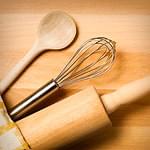
The colored inks show how fluid particles interact together. Radiant heat would only travel in straight lines.
Plus: it looks cool.
Kitchen Mysteries is a weekly exploration of oddities surrounding cooking and food. They could be recipes that fail when they shouldn’t, conflicting advice from different sources, or just plain weirdness. If it happens in a kitchen, and you’re not sure why, send atweet to The Food Geekto find out what’s happening.
Friend of The Food Geek, Valerie, asks:

Hi, Valerie,
There’s some theory to understand, and there are some rules of thumb. Let’s start with the theory.
We know from previous articles that normal ovens work on radiant heat. Radiant heat is very gentle, and allows whatever you’re cooking to be gradually heated. It gives you a great deal of fine-grained control over whatever you’re cooking. In terms of Olympic sports, radiant heat is fencing: there are real muscles involved, but the winner will be the one with the speed, reflexes, and subtle strategies.
When you move to a convection oven, you don’t want to throw all that away. After all, people are used to ovens behaving in a certain manner, and if you completely change it, then there’ll be confusion, and you’ll need at least two ovens to get anything done, and puppies will cry, and so on. Even so, there are some definite shortcomings to pure radiant cooking, some of which we discussed last week.
因为辐射烹饪非常微妙,influenced by just about everything. Color, for example. Do you think a Fry-O-Lator cares what color the battered chicken is when you put it in? It does not. It’s just going to go mad with frying power and cook your food. Radiant heat does care about color. Radiant heat will heat darker things faster than lighter things, because lighter things reflect radiant energy (such as light) better than darker things. So, we want something that’s less susceptible to environmental forces than radiant heat but not as implacable as, say, boiling oil. For this, we turn to air, and convection heat transfer.
In many ways, convection and radiant heat are the same thing. With both, you are bouncing something off of something else and the resulting interaction causes some heat to be transferred. With radiant heat, you are bouncing electromagnetic radiation, andwith convection you are bouncing fluid particles (liquid or air). The big differences are that:
- Radiant heat travels only in a straight line, with some exceptions that don’t generally affect how your cake will emerge from the oven. Whereas particles will bounce around and swirl and do crazy things that are not necessarily purely linear;
- Fluid particles have more mass than radiant heat, so it transfers more energy per unit;
- Fluid particles interact with each other, so they will transfer heat to each other, quickly evening out the heat between the various particles. Heat just hits things and either transfers heat or reflects, so unevenness is almost certain.
Based on all of this, we know that, in general, you aren’t going to need as high of a temperature in the oven to cook your food, because the heat is going to be transferred more efficiently. Yourdark pans won’t be affected as much as they would in a regular oven, and larger, suspended products (turkeys, for example) will be heated more evenly without rotation.
So, rule of thumb: lower the temperature by 25°F (Roughly 15°C). Keep a nose out for your food, and pay attention when it smells like it’s done. Check a little more frequently than you normally would, but still try not to open the oven door if you don’t need to.























Comments
Leave a Comment
Comments
-

mrsrev | 05/27/2016
-

Suevani | 11/25/2010
Show Morewhere are the answers to above questions?
I am new to convection cooking. I have a Viking dual fuel range. I would like to know how long and at what temperature to cook a 22 pound Thanksgiving turkey on the convection roast setting, which I am assuming I should use. Any information, advice or tips would be appreciated. Thank you.